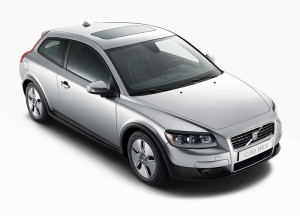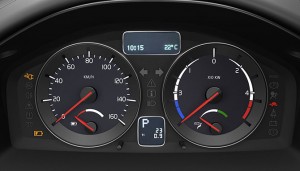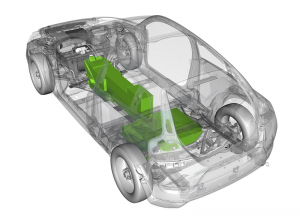Sep
25
The Super Sexy Swedish Electric Stunner
September 25, 2009 | 7 Comments
Perhaps you remember when Volvos looked like they were carved from wood by an axe while other manufacturers were going windswept and aerodynamic. Then they finally switched to svelte a decade or so back and improved on that while others have moved on to muscular, angular and blocklike. One wonders who is leading whom.
Volvo Cars is currently evaluating the viability of a fully battery-electric vehicle (BEV). This year, Volvo has built and internally testing a small number of prototype versions of a BEV version of its C30. In addition to focusing on performance and safety, much of the focus is on integration of the electric propulsion system with the rest of the car.
The electric Swedish stunner is built on the C30 hatchback and comes with all the safety, comfort and space we expect from Volvo. The company already is working on a Volvo plug-in hybrid due in 2012, but seems to be building a city car with the C30.
Lennart Stegland, director of Volvo Cars Special Vehicles, said in a corporate statement, “The Volvo C30 is the first model we will try out with electric power. This car’s excellent properties in city traffic and its relatively low weight make it particularly suitable, since electric cars are primarily expected to be used in and around cities and for daily commuting.”
Are we seeing the slow death of the SUV, minivan and others with a birth of a city car, over the road car and other more energy wise vehicle types? Or are we just seeing a new car class being born? The Volvo C30 is far more substantial than the Smart Car and other two seat city car contenders.
The C30 BEV is limited to a top speed of about 130 km/h (80 mph)—more than sufficient, Volvo says, for a city car application. Acceleration from 0 to 100 km/h (62 mph) will take less than 11 seconds. The car would have a range of up to 150 kilometers (93 miles)—longer than the distance 90% of all Europe’s motorists drive per day and surely covers a wide swath of U.S. motorists as well.
Volvo’s battery choice for the C30 BEV is designed and developed in the U.S. by EnerDel, Inc., Ener1’s U.S. battery subsidiary. This adds to the recently announced collaboration with Volvo on the V70 model plug-in hybrid demonstration vehicles being road tested in Europe starting this fall, which are also using the EnerDel lithium-ion batteries.
Using EnerDel’s EV chemistry, hard carbon and mixed oxide in a lithium-ion battery pack, yields gross nominal power of 24 kWh lithium-ion battery pack and is said to be considering a 12 kWh pack. The EnerDel battery set is custom-made and is a split battery pack. With an energy content of more than 24 kWh nominal energy, Volvo plans that 22.7 kWh is used to power the car.
The electric traction motor is located under the hood, just like the engine in a conventional front wheel drive car. One of the priorities of the Volvo project is to find the optimal placing of the battery. Most likely it will be the prop shaft tunnel and where the fuel tank normally is located. These locations are within the car’s optimized crumple zone in the most common collision scenarios.
Recharging the C30’s EnerDel battery pack via a household supply at 230V, 16A would take about eight hours. That’s a rate similar to a mid sized window air conditioner, meaning consumers would only need a 20 amp 240 volt outlet where parking overnight.
Volvo has already built a small number of the cars and begun testing. Volvo says the early testing has focused largely on integrating the electric drive train with the rest of the car.
Volvo always emphasizes its focus on safety, saying that if it chooses to introduce an entirely new type of electric car on the market, it will be just as safe as any other car bearing the Volvo badge. Volvo has been working to theoretically identify all the electrification-related safety scenarios in the stages before, during and after a collision. After careful study of these scenarios, the company’s engineers will create solutions for handling each and every situation identified, “guaranteeing that any future electric cars fully match Volvo’s safety standards in every respect.” Considering the Volvo record, that is as sure a thing as can be credible.
Volvo plans the main electrification track over the coming decades will be plug-in hybrids. That track applies in particular to the company’s larger car models. The combination of an electric motor and combustion engine is a solution that probably has the greatest potential from both the technical and commercial viewpoints. Plug-in hybrids offer long range, good environmental performance and at the same time limited dependence on expensive battery technology while cutting back on the fossil fuel demand.
From the three point seat belt invented at Volvo and licensed without charge to anyone world wide, to the research and development of the O2 sensor (called lamdasond) also made available at very low license rates to encourage development worldwide, Volvo is a major innovator in motor vehicles. Maybe those ax carved body designs were early visions of what’s to come, and they did come.
Volvo’s Paul Gustavsson, Director of Electrification Strategy at Volvo Cars said, “The consumer must feel that this [battery electric] car is attractive both to drive and own. In order to ensure this, we feel that electric cars will have to be as comfortable and safe and offer similar levels of performance as cars with other power sources. The learning from the C30 BEV project will help us to fulfill all these criteria and showcase Volvo’s determination to drive developments in the field of electrification.”
Volvo is currently owned and a division of sorts of the Ford Motor Company, the one last standing non-bankrupt U.S. automaker. For all the storied past from Ford both good and bad, the current leadership have been excellent stewards. Volvo is said to be available for sale, but the price must be very high. It has to be, one would think, the Volvo status is the safest, sanest and efficient cars that are priced within reach of the U.S. and world middle class. Volvo may be a small make, but its one of the major ones to watch.
Comments
7 Comments so far






[…] This post was mentioned on Twitter by Electricity Pricing. Electricity Pricing said: The Super Sexy Swedish Electric Stunner | New Energy and Fuel http://bit.ly/BWtXi […]
Beneficial info and excellent design you got here! I want to thank you for sharing your ideas and putting the time into the stuff you publish! Great work!
This post makes a lot of sense !
Nice post! You truly have a wonderful way of writing which I find captivating! I will definitely be bookmarking you and returning to your blog. In fact, your post reminded me about a strange thing that happened to me the other day. I’ll tell you about that later…
Of course, what a great site and informative posts, I will add backlink – bookmark this site? Regards, Reader
Volvo is still my favorite car. I had been driving volvo criterion for 9 years.
I bought a used Volvo S60 2004 car from a buy and sell website and I been driving it for 5 years and I never experience having a major problem with the car. Next year I’m planning to buy an electric car and I think should buy the same brand.